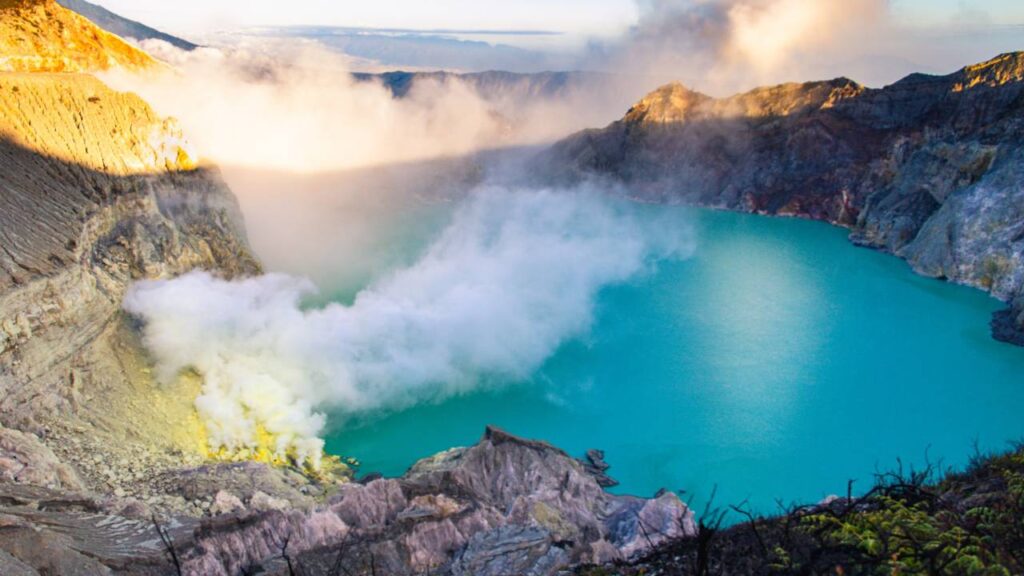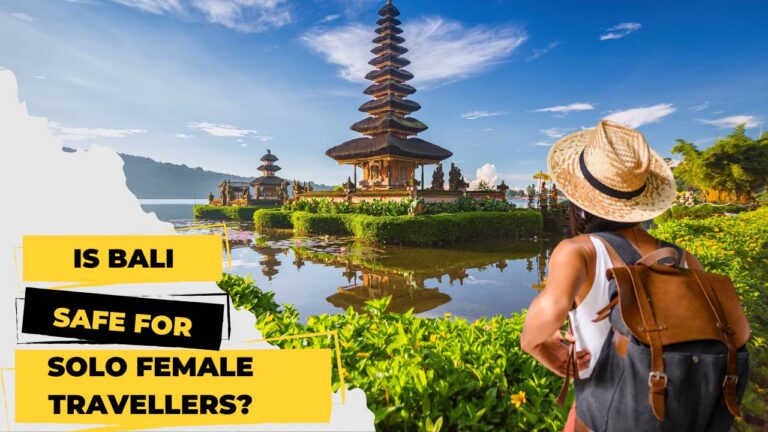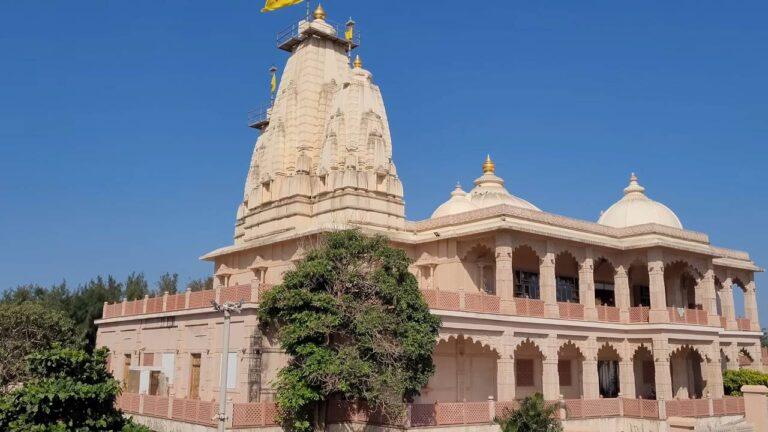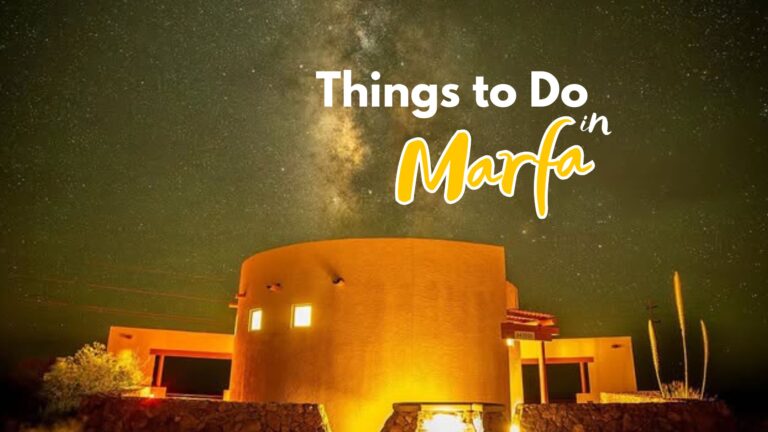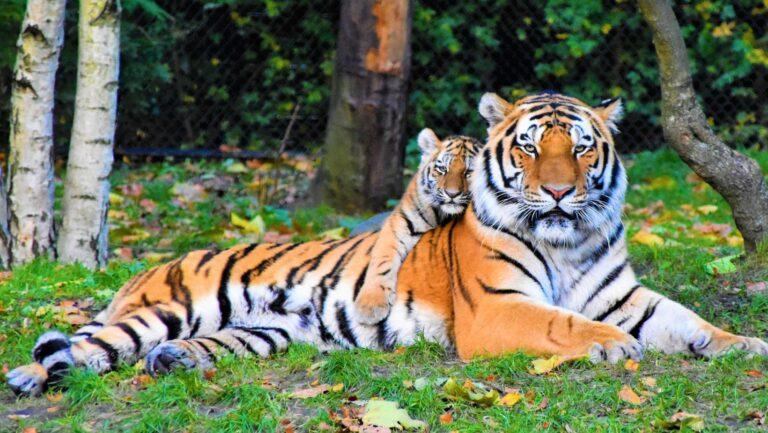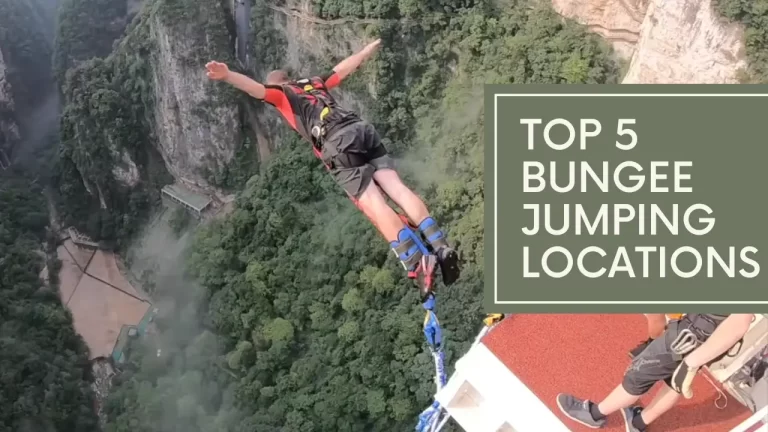Kawah Ijen’s glowing blue fire—one of the rarest natural wonders on Earth. Find out why this midnight volcano hike deserves a top spot on your travel bucket list!
Hidden within the rugged landscapes of East Java, Indonesia, Kawah Ijen is a name that stirs both curiosity and awe among adventurers, photographers, and nature lovers. Famous for its surreal blue fire phenomenon, this natural wonder is unlike any other volcanic site in the world. From its otherworldly glow at night to the stunning turquoise crater lake by day, Kawah Ijen is not just a destination—it’s an experience that imprints itself on your soul. If you’re planning to witness one of Earth’s rarest natural spectacles, this detailed guide covers everything you need to know before your trip.
Where Is Kawah Ijen?
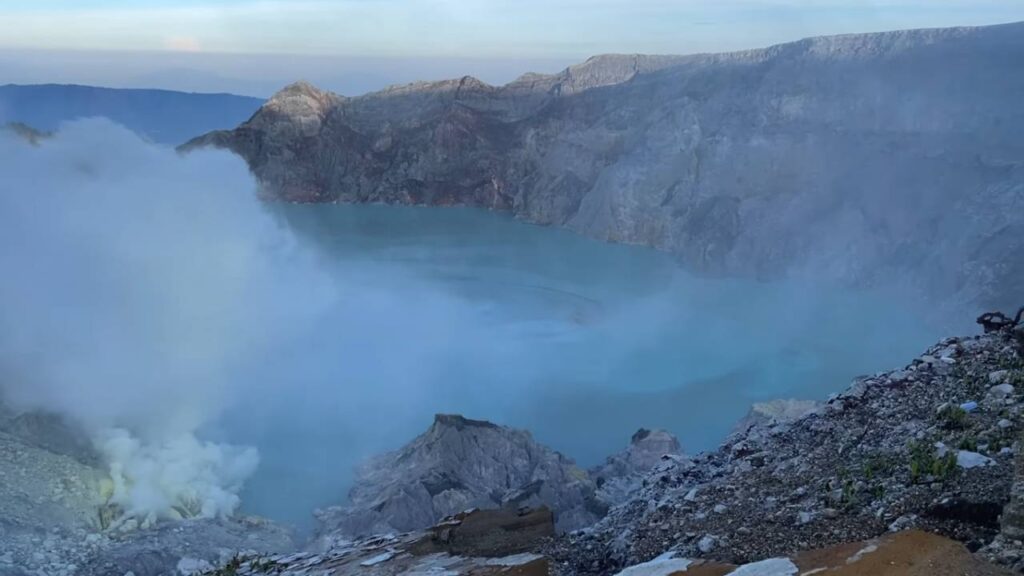
Kawah Ijen is located in East Java, Indonesia, and forms part of the Ijen volcano complex. Located between the regencies of Banyuwangi and Bondowoso, it lies in the Ijen Plateau, about 2,799 meters above sea level. The centerpiece of this complex is the Ijen crater, renowned not only for its eerie blue flames but also for housing the world’s largest highly acidic crater lake. Surrounded by dense forest and rugged terrain, Kawah Ijen is accessible yet feels like a portal to another planet. This remote yet increasingly popular destination is a must-visit for anyone exploring Java or undertaking a broader Indonesian adventure.
How To Get To Kawah Ijen
Reaching Kawah Ijen, one of Indonesia’s most iconic volcanic craters, takes some planning, but the journey is part of the adventure. This otherworldly destination is famous for its striking blue fire phenomenon, turquoise sulfur lake, and active mining area. Most travelers begin their journey from either Banyuwangi or Bondowoso, with Banyuwangi being the more popular and convenient choice due to its better infrastructure, easier road access, and variety of transport options.
Getting to Banyuwangi
By Air:
Domestic flights are available from Jakarta, Surabaya, and Bali to Banyuwangi Airport (Blimbingsari Airport). Flights are relatively short and ideal for travelers who want to save time. The airport is only about 30–45 minutes from the city center.
By Train:
There are daily train services from Surabaya to Banyuwangi, typically taking 6–7 hours. The journey is scenic, especially in the daytime, passing through lush rice fields and rural landscapes. Trains arrive at Banyuwangi Baru Station, which is close to hotels and ferry ports.
By Ferry (from Bali):
If coming from Bali, you can take a bus or private car to Gilimanuk Port, then board a ferry to Ketapang Port in Banyuwangi. The ferry ride takes about 45 minutes to an hour and operates 24/7, making it one of the easiest and most flexible options. From Ketapang, you’re just a short ride from Banyuwangi city.
From Banyuwangi to Paltuding Base Camp
Once in Banyuwangi, the next step is getting to the Paltuding base camp, the official starting point of the Kawah Ijen trek. This drive takes approximately 1.5 to 2 hours, and although the distance isn’t long, the mountain roads are narrow, steep, and winding. Hiring a private car with a driver is the safest and most recommended option. Adventurous travelers sometimes rent motorbikes, but it’s only advisable if you’re confident in riding in rough terrain and darkness.
Can also join a guided tour, which usually includes transport, entrance fees, a gas mask, and a local guide who is familiar with the route and safety precautions.
Kawah Ijen Entrance Fee
Visiting Kawah Ijen isn’t just a typical hike—it’s a rare opportunity to witness natural phenomena like the blue fire, acidic turquoise lake, and the daily labor of traditional sulfur miners. Due to its geological uniqueness and environmental sensitivity, the area is protected, and visitors are required to pay an entrance fee. This fee directly supports the conservation efforts, trail maintenance, safety regulations, and management of the national park area.
Entrance Fees for International Tourists
For foreign visitors, the entrance fee is typically IDR 100,000 (approximately $6.50 USD) on regular weekdays. If planning to visit on a weekend or national holiday, the fee increases to IDR 150,000 (about $10 USD). The higher weekend rate helps manage the increased foot traffic during busy days and contributes extra support toward preserving the ecosystem from high volumes of visitors.
It’s important to note that these fees are for park entry only. They do not include additional services such as guides, equipment rentals, or transportation to and from the base camp. Prices may be revised by local authorities depending on tourism seasons, conservation needs, or infrastructure improvements.
Entrance Fees for Domestic Tourists
If an Indonesian citizen, the entry cost is significantly lower to encourage local tourism and ensure accessibility for residents. On weekdays, locals typically pay around IDR 5,000 to 10,000, while on weekends and public holidays, the fee ranges between IDR 7,500 to 15,000. The tiered system makes it more affordable for domestic travelers to visit their own natural heritage.
For students or organized educational groups, there may be special discounted rates, especially if visiting as part of an academic tour. Identification, such as a national ID or student card, is usually required to qualify for local pricing.
Other Charges to Consider
Beyond the entry fee, there are several optional but important expenses that visitors should prepare for. One of the most essential is the gas mask rental, which typically costs between IDR 25,000 to 50,000. Since the sulfuric fumes near the crater can be harmful, especially during the blue fire trek, wearing a proper mask is not just advisable—it’s a matter of safety.
Hiring a guide is highly recommended, especially if you plan to hike in the dark to see the blue flames. Guides usually charge IDR 100,000 to 200,000, depending on group size and services offered. Many guides are local miners themselves, with extensive knowledge of the terrain, volcanic activity, and cultural history of the site.
Some areas may also request a small additional fee for camera usage, particularly if you are using a DSLR, drone, or any professional photography gear. While casual tourists with smartphones are usually exempt, it’s wise to check with local officials or your guide.
Transport & Access Costs
Getting to Paltuding Base Camp, the main starting point of the trek, often involves additional transport costs. If not part of a guided tour, you’ll likely need to arrange a private car or shared vehicle, which can range from IDR 300,000 to 600,000 depending on the distance and your negotiation skills. Roads to the base camp can be narrow, bumpy, and remote, so hiring a reliable driver is important for safety and convenience.
Best Time to Visit Kawah Ijen
Timing your visit to Kawah Ijen can greatly enhance your overall experience, especially if your goal is to witness its most famous attractions: the blue fire, the acidic turquoise crater lake, and the sulfur mining activity. Due to the unique combination of natural elements involved, the weather and season play a critical role in both accessibility and visibility.
Dry Season: May to October – Ideal Window
The dry season, which runs from May through October, is widely considered the best time to visit Kawah Ijen. During these months, East Java experiences significantly lower rainfall, offering clear skies, stable weather, and better trail conditions. These factors are essential for a safe and enjoyable trek, especially when hiking in the dark to see the blue flames.
One of the key advantages of visiting in the dry season is the improved visibility at the summit. The iconic electric-blue sulfur flames are best seen when the air is dry and free from mist or rain. Additionally, sunrises tend to be more dramatic and picturesque, offering a clear panoramic view of the crater and surrounding volcanic peaks.
The trail leading to the summit is more navigable during the dry season. The 3-kilometer hike from Paltuding Base Camp can become steep and slippery during the rainy season, so dry conditions make the ascent much safer and more manageable for both beginners and seasoned hikers.
Rainy Season: November to April – Travel With Caution
While Kawah Ijen remains open year-round, the rainy season, stretching from November to April, can pose significant challenges. Heavy rain is common during this period, especially in January and February, often resulting in muddy and slippery trails that make the hike physically demanding and potentially dangerous.
Visibility also tends to be poor during the rainy months. Dense fog and cloud cover frequently blanket the area, which can obscure views of the blue flames, the crater lake, and even the sulfur mining activity. Moreover, because the sulfur gases become heavier in moisture-rich air, you may experience stronger, more suffocating fumes that can affect breathing—even with a gas mask.
In cases of extreme weather or elevated volcanic activity, the national park authorities may temporarily close the trail for safety reasons. This is more likely to happen during the wet season, making it a less predictable time for visitors hoping to see Kawah Ijen at its best.
Best Time of Day: Midnight to Early Morning
Midnight to Early Morning (12:00 a.m. to 3:00 a.m.)
1. Blue Fire Visibility
The blue fire is one of the most unique and mesmerizing sights at Kawah Ijen. These blue flames, caused by the ignition of sulfuric gases, are only visible in the complete darkness of night. The ideal time to see the blue fire is between 2:00 a.m. and 3:30 a.m., when the gases are ignited and the glow is at its most intense.
2. Hiking Start Time
To catch this stunning natural phenomenon, most hikers begin their trek around 12:00 a.m. to 1:00 a.m. from the Paltuding Base Camp. This gives enough time to climb the 3-kilometer trail, which takes about 1.5 to 2 hours to reach the summit. Starting at midnight allows you to reach the top just in time for the first glimpse of the blue fire before it fades with the dawn.
3. Cold Temperatures
Night hike comes with colder conditions, especially at higher altitudes. Temperatures can drop to around 5°C to 10°C (41°F to 50°F). It’s essential to bring warm clothing such as a jacket, gloves, and layers to stay comfortable during the climb. Even though you’ll be exerting energy while hiking, the chill in the air can make the experience quite cold, particularly if you’re standing still to admire the blue fire.
4. Sulfur Gas Conditions
Sulfur gases, which cause the blue fire, are less intense in the early morning before the winds shift. By hiking at night, you can experience the spectacle without being overwhelmed by the heavy sulfur fumes that can be quite harsh during the daytime. Gas masks are still recommended, but the cooler morning air often makes it easier to handle the fumes.
Sunrise Viewing (Around 5:00 a.m. to 5:30 a.m.)
After the blue fire fades, the sunrise over Kawah Ijen is another incredible highlight of the trek. Around 5:00 a.m., the first light of day begins to illuminate the turquoise crater lake, creating breathtaking golden light over the landscape. The changing light over the sulfur lake and surrounding volcanic terrain offers stunning photo opportunities and makes for an unforgettable visual experience.
Photo Opportunity
The early morning light provides the perfect conditions for photography. The dramatic interplay between the dark volcanic terrain and the soft, golden sunrise offers a vivid contrast that is perfect for capturing the beauty of Kawah Ijen. The clear skies at sunrise allow you to take sharp, colorful photos of the crater lake, the sulfur mines, and the mountainous surroundings.
Where to Stay in Kawah Ijen
While there are no accommodations directly at the summit or the crater of Kawah Ijen, there are several towns and resorts nearby where you can stay comfortably before embarking on the hike. The two main places to base yourself are Banyuwangi and Licin, with a variety of lodging options ranging from eco-friendly resorts to budget guesthouses.
Here are some of the most popular places to stay near Kawah Ijen:
1. Jiwa Jawa Resort Ijen – An Eco-Friendly Resort with Scenic Views
Location: Close to the Ijen Crater, located in the village of Sempol, in the Ijen Plateau.
Vibe: A luxurious, eco-friendly resort offering a tranquil and immersive nature experience. The resort is nestled in the hills, providing panoramic views of the surrounding mountains and forests.
Accommodation: The resort features comfortable, well-designed rooms with modern amenities such as air conditioning, private bathrooms, and hot water. The rooms offer a blend of rustic charm and modern convenience, making it a perfect retreat after your hike.
Facilities: Guests can enjoy the resort’s swimming pool, restaurant, and wellness facilities, making it an ideal spot to relax after a day of exploring. The resort also offers guided tours, making it easier for you to organize your Kawah Ijen adventure.
Special Feature: Known for its hospitality and personalized service, Jiwa Jawa Resort Ijen offers a peaceful, scenic atmosphere that is perfect for those looking for an upscale, yet nature-inspired experience.
2. Kampung Osing Inn – Budget-Friendly with Local Atmosphere
Location: Situated in Banyuwangi, this guesthouse offers an affordable option for travelers who want to experience the local culture.
Vibe: With a traditional and homely ambiance, Kampung Osing Inn brings a more authentic feel of the local culture, giving visitors a chance to immerse themselves in the everyday life of the people of Banyuwangi.
Accommodation: The rooms here are simple but comfortable, providing basic amenities such as comfortable bedding, shared bathrooms, and fan rooms. The inn has a cozy, family-run feel with friendly and welcoming staff who can offer tips and guidance about your visit to Kawah Ijen.
Facilities: Guests enjoy access to common areas, such as a lounge and garden, ideal for relaxing in the evening. The guesthouse also offers delicious, homemade local meals, giving you a taste of the local cuisine.
Special Feature: Kampung Osing Inn is known for its affordability and the chance to meet other like-minded travelers, making it a great choice for those on a budget.
3. Ketapang Indah Hotel – A Comfortable Stay Near Ketapang Harbor
Location: Situated just outside Ketapang Harbor, which serves as the main entry point from Bali, Ketapang Indah Hotel is about a 30-minute drive from the Ijen Crater.
Vibe: This mid-range hotel provides a relaxing environment with beautiful garden settings and a welcoming atmosphere. Its proximity to the harbor makes it a great choice for those traveling from Bali via ferry to Banyuwangi.
Accommodation: The hotel offers a variety of room options, including standard rooms and deluxe suites, all of which are well-maintained and come with modern amenities like air conditioning, private bathrooms, and TVs. The rooms are comfortable and spacious, providing a nice balance between quality and affordability.
Facilities: The hotel features well-maintained gardens, a swimming pool, and a restaurant offering local and international cuisine. It also provides shuttle services to the harbor and to nearby attractions, including Kawah Ijen, which makes it a convenient base for exploring.
Special Feature: Ketapang Indah Hotel is praised for its excellent service and beautiful surroundings, making it a solid choice for those who want comfort and convenience without breaking the bank.
4. Paltuding Area – Basic Accommodations for Early Access to the Hike
Special Feature: While the accommodations are more basic compared to other options, staying near Paltuding ensures you are at the heart of the action and can start your hike at the optimal time for viewing the blue fire.
Location: Paltuding Base Camp is the starting point for the hike to Kawah Ijen, located about a 1.5-hour drive from Banyuwangi. The area around Paltuding is more remote and quieter, offering basic lodging for hikers looking to get closer to the crater.
Vibe: The accommodations here are simple and no-frills, designed mainly for those who want to stay close to the starting point of the hike. This is the most convenient place if you prefer to minimize travel time and get an early start on the trek.
Accommodation: Options around Paltuding are limited, with basic guesthouses and small lodges offering simple rooms. These typically have shared bathrooms and minimal amenities, but they are perfectly adequate for hikers needing a place to rest before the early morning trek.
Facilities: Basic facilities include shared kitchens and common areas where travelers can relax. Some accommodations may offer guides or transportation to and from the trailhead.
Things to Do in Kawah Ijen
Kawah Ijen is a remarkable destination that offers a wide array of stunning and unique experiences, beyond just the famous blue fire. An adventurer, photographer, or nature lover, there’s something special for everyone. Here’s a more detailed look at the top activities and sights you should not miss when visiting Kawah Ijen.
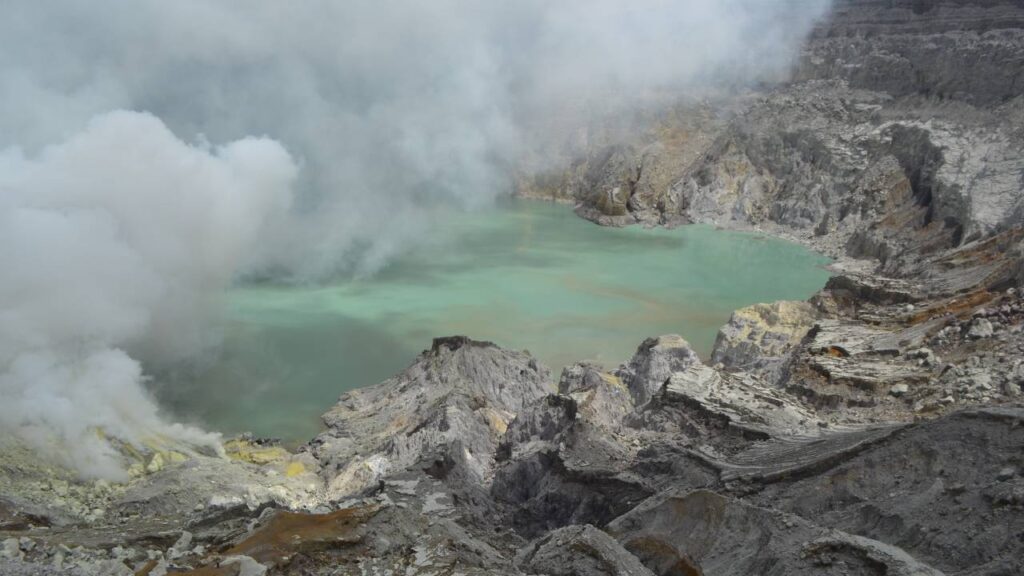
1. Witness the Blue Fire
The blue fire is undoubtedly the most famous attraction at Kawah Ijen, drawing visitors from around the world. This phenomenon occurs when sulfuric gases escaping from the volcano’s cracks are ignited by the heat of the volcano’s interior. The result is a stunning electric-blue flame that dances in the dark of the night. Kawah Ijen is the only place in the world where you can witness this blue fire up close, making it a once-in-a-lifetime experience.
To see the blue fire, most trekkers start their journey around midnight or 1 a.m. This is when the flames are most visible, and the hike offers a unique adventure through the dark volcanic terrain. The sight is mesmerizing, especially with the glowing blue fire contrasting against the black, rocky backdrop of the crater. It’s an incredible spectacle that attracts travelers and photographers alike, eager to capture this rare and ethereal sight.
2. Visit the Sulfur Mines
One of the most powerful experiences at Kawah Ijen is the opportunity to see the sulfur mines in action. The crater area is home to an active mining operation, where local miners brave extreme conditions to collect sulfur deposits. These miners work tirelessly, carrying large baskets filled with solidified sulfur, sometimes weighing up to 70–90 kg (154–198 lbs), from the crater floor to the rim.
This sight is both awe-inspiring and sobering, as you watch the miners perform this grueling task under difficult circumstances. They face extremely high temperatures and dangerous sulfuric gases while working in a perilous environment. Their resilience in the face of such harsh conditions provides a fascinating glimpse into the human connection with the volcanic landscape and the history of sulfur mining in the area.
It’s important to approach this activity with respect, as the sulfur mining operation is still a key part of the local economy, though it is a difficult and hazardous profession.
3. See the Acidic Crater Lake
By day, Kawah Ijen reveals one of its most beautiful and dangerous features: the acidic crater lake. The lake, which fills the crater at the summit of the volcano, is the largest highly acidic lake in the world. Its waters are bright turquoise, creating an otherworldly contrast against the rugged volcanic landscape. The color of the lake comes from the high concentration of sulfuric acid, which makes the lake highly toxic and extremely hazardous to get near.
The lake is stunning to look at, with the ever-changing light creating vivid reflections of the surrounding mountains. While the lake itself is a natural beauty, visitors must remember that it is dangerous and not suitable for swimming. The acidic water can corrode metal and harm the skin, making it a reminder of the raw power of the volcano. For photography enthusiasts, the combination of the vibrant lake and the surrounding landscape makes for a spectacular shot during daylight hours.
4. Sunrise Views
After the intense night trek and witnessing the blue fire, the sunrise at Kawah Ijen offers another breathtaking experience. If you manage to stay at the crater’s rim after the blue fire spectacle, you’ll be treated to one of the most magnificent sunrises in Indonesia. The sun rises over the surrounding mountains, painting the sky in shades of gold, pink, and orange, while the mist from the crater lake creates an ethereal scene.
The view from the rim is expansive, offering panoramic vistas of the nearby volcanic peaks and lush forests. The early morning light casts beautiful shadows across the landscape, making this a perfect time for photography. As the sun rises, the light illuminates the crater and the surrounding area, providing a completely different perspective from the dark, eerie atmosphere of the night.
5. Photography Opportunities
Kawah Ijen is a paradise for photographers, offering a range of unique photo opportunities. Whether you’re into astrophotography at night, capturing the mesmerizing blue fire in the darkness, or taking dramatic shots of the crater lake during sunrise, there’s no shortage of spectacular views to capture. The contrast of the dark volcanic landscape with the glowing blue fire creates stunning visuals, while the turquoise lake and surrounding mountains offer dramatic daytime shots.
Additionally, the sulfur mines provide an opportunity to document the human element of the region. The miners, their hard work, and the volcanic landscape create striking photographs that tell the story of life in such an extreme environment. Each time of day brings a new perspective and a fresh set of colors and lighting conditions, making Kawah Ijen an essential location for anyone with a passion for photography.
Is Kawah Ijen Safe to Travel?
Kawah Ijen is a unique and awe-inspiring destination, attracting adventure seekers and nature lovers from around the world. While the site is generally safe for visitors, it’s essential to recognize that it presents a set of natural hazards that require careful preparation and respect for the environment.
These risks are mainly related to the sulfuric gases, the treacherous hiking trails, and the unpredictable weather conditions, all of which can make the experience more challenging than other typical tourist sites. Let’s visit these risks in detail and how you can stay safe while enjoying the wonders of Kawah Ijen.
Sulfuric Gas Exposure
One of the most significant hazards at Kawah Ijen is the presence of toxic sulfuric gases that continuously escape from the crater. These gases, particularly sulfur dioxide, are highly harmful if inhaled and can cause serious respiratory issues, even for short periods of exposure. The gases are particularly concentrated near the sulfur vents and in the lower parts of the crater, making it essential for visitors to take precautions.
- Gas Mask Requirement: When trekking to the crater and particularly when getting close to the sulfur mines and vents, it’s important to wear a gas mask. The sulfuric fumes can cause irritation to the eyes, nose, and throat, and prolonged exposure can lead to more serious respiratory problems. Fortunately, most guided tours include a gas mask as part of the tour package. It’s essential to wear the mask whenever you are in these higher-risk areas to ensure you are protected from the fumes.
- Know the Wind Conditions: Wind direction can affect the intensity of sulfur gas exposure. On calm days, the sulfur can build up near the crater, but on windy days, the gases may be dispersed. Your guide will typically monitor this and advise you when to be extra cautious or take a different path.
Challenging Hiking Conditions
Reaching the summit of Kawah Ijen involves a challenging hike, especially in the dark. The trail is about 3 kilometers long, but the ascent is steep and often rough, especially as you near the crater. While the trek is not extremely technical, it does require a certain level of fitness and awareness.
- Darkness: Since most visitors begin their hike around midnight to catch the blue fire, you’ll be walking in complete darkness for a portion of the journey. Navigating the rocky paths can be tricky, and a flashlight or headlamp is absolutely essential. These will help illuminate the path and ensure that you don’t trip or stray off the marked trail.
- Steep and Rocky Terrain: The trail to the summit includes steep sections and uneven, rocky terrain, so it’s vital to have the right footwear. Sturdy hiking boots with good grip are recommended to prevent slips and to provide ankle support, especially on loose rocks or when navigating the steep incline.
- Weather Conditions: Temperatures at the summit can be cold, particularly in the early hours of the morning, with temperatures potentially dropping to near freezing. It’s important to wear warm layers (preferably moisture-wicking and insulated clothing) to stay comfortable during the night hike and at the crater’s rim.
Unpredictable Weather
Kawah Ijen’s altitude and location can lead to rapidly changing weather conditions. While the dry season (May to October) is generally the best time to visit, the weather can still be quite unpredictable, especially at night. Even if the forecast is clear, you may encounter fog, strong winds, or sudden drops in temperature.
- Rain: During the rainy season (November to April), the trails can become slippery and muddy, making the hike more difficult and dangerous. Heavy rainfall can also lead to the temporary closure of the site for safety reasons. If you plan to visit during this time, it’s important to check the weather forecast beforehand and be prepared for possible trail closures.
- Cold and Wind: The higher altitude at the summit results in significantly cooler temperatures, and wind chill can make it feel even colder. It’s advisable to dress in layers, including a windproof jacket to protect yourself from the cold wind. Make sure you have gloves, a hat, and a warm, insulated jacket, especially if you plan to stay for the sunrise.
Staying on Marked Trails
While the natural beauty of Kawah Ijen is captivating, it’s important to stick to the marked trails to avoid putting yourself in danger. The sulfuric gases are strongest around the sulfur mining area and near the acidic crater lake, where the terrain can be unstable and treacherous. Venturing off the path can lead to serious risks, including exposure to toxic gases and the danger of falling into the acid lake or slipping on loose rocks.
- Avoid Restricted Areas: There are specific zones that are off-limits to tourists due to the dangerous conditions or active mining operations. These areas are often marked, and local guides will direct you safely around them. It’s important to follow the advice of your guide and avoid straying into these restricted zones.
Go with a Guide
Given the challenging and potentially hazardous conditions, it is highly recommended to trek with a guide. A local guide will not only ensure that you stay on the safe path but also provide valuable insight into the area, including its geological and cultural significance. They are familiar with the trail and the best times to visit specific areas, ensuring that you get the most out of your experience.
- Benefits of a Guide: A guide will also help you manage sulfur gas exposure, advise on the best time to trek, and assist in any emergencies. Local guides are well-trained to handle the terrain and weather conditions, making the hike safer for tourists.
A seasoned traveler or a curious explorer, adding Kawah Ijen to your bucket list will redefine the way you see the planet’s natural beauty.
FAQs
1. What is Kawah Ijen famous for?
Kawah Ijen is renowned for its stunning blue fire phenomenon, where sulfur gases ignite and create an eerie, electric-blue flame at night.
2. Where is Kawah Ijen located?
Kawah Ijen is located in East Java, Indonesia, within the Ijen volcano complex, between the Banyuwangi and Bondowoso regencies.
3. How do I get to Kawah Ijen?
You can reach Kawah Ijen by flying into Banyuwangi or Bondowoso and then taking a car or tour to the Paltuding base camp before hiking up to the crater.
4. What is the best time to visit Kawah Ijen?
The best time to visit is during the dry season, between May and October, when the weather is more favorable for hiking and sightseeing.
5. What is the Kawah Ijen entrance fee?
The entrance fee for international visitors is typically around IDR 100,000 (about $6.50) on weekdays and IDR 150,000 (about $10) on weekends and public holidays.
6. Can I see the blue fire during the day?
No, the blue fire is only visible at night or in the early morning hours when sulfur gases ignite in the dark, creating the blue glow.
7. Is it safe to hike Kawah Ijen?
While generally safe, the hike involves steep trails and exposure to sulfur gases. It’s recommended to go with a guide, wear a gas mask, and take proper precautions.
8. How long does the hike to Kawah Ijen take?
The hike from the Paltuding base camp to the crater takes about 1.5 to 2 hours, depending on your pace.
9. What should I bring for the hike to Kawah Ijen?
Bring a flashlight or headlamp, a warm jacket, sturdy shoes, a gas mask (if not provided by a guide), and plenty of water.
10. Where can I stay near Kawah Ijen?
You can stay in nearby towns like Banyuwangi or Licin, with options ranging from budget guesthouses to eco-friendly resorts like Jiwa Jawa Resort Ijen.
